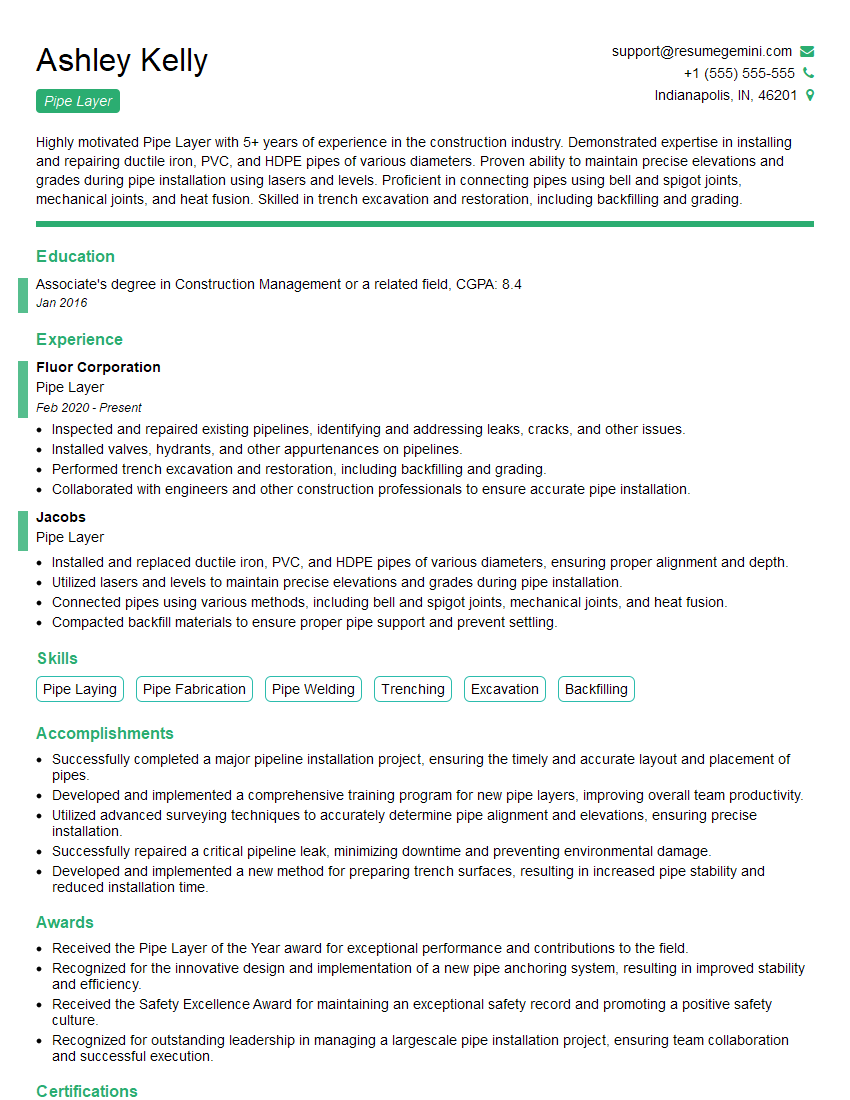Are you a seasoned Pipe Layer seeking a new career path? Discover our professionally built Pipe Layer Resume Template. This time-saving tool provides a solid foundation for your job search. Simply click “Edit Resume” to customize it with your unique experiences and achievements. Customize fonts and colors to match your personal style and increase your chances of landing your dream job. Explore more Resume Templates for additional options.

Ashley Kelly
Pipe Layer
Summary
Highly motivated Pipe Layer with 5+ years of experience in the construction industry. Demonstrated expertise in installing and repairing ductile iron, PVC, and HDPE pipes of various diameters. Proven ability to maintain precise elevations and grades during pipe installation using lasers and levels. Proficient in connecting pipes using bell and spigot joints, mechanical joints, and heat fusion. Skilled in trench excavation and restoration, including backfilling and grading.
Education
Associate’s degree in Construction Management or a related field
January 2016
Skills
- Pipe Laying
- Pipe Fabrication
- Pipe Welding
- Trenching
- Excavation
- Backfilling
Work Experience
Pipe Layer
- Inspected and repaired existing pipelines, identifying and addressing leaks, cracks, and other issues.
- Installed valves, hydrants, and other appurtenances on pipelines.
- Performed trench excavation and restoration, including backfilling and grading.
- Collaborated with engineers and other construction professionals to ensure accurate pipe installation.
Pipe Layer
- Installed and replaced ductile iron, PVC, and HDPE pipes of various diameters, ensuring proper alignment and depth.
- Utilized lasers and levels to maintain precise elevations and grades during pipe installation.
- Connected pipes using various methods, including bell and spigot joints, mechanical joints, and heat fusion.
- Compacted backfill materials to ensure proper pipe support and prevent settling.
Accomplishments
- Successfully completed a major pipeline installation project, ensuring the timely and accurate layout and placement of pipes.
- Developed and implemented a comprehensive training program for new pipe layers, improving overall team productivity.
- Utilized advanced surveying techniques to accurately determine pipe alignment and elevations, ensuring precise installation.
- Successfully repaired a critical pipeline leak, minimizing downtime and preventing environmental damage.
- Developed and implemented a new method for preparing trench surfaces, resulting in increased pipe stability and reduced installation time.
Awards
- Received the Pipe Layer of the Year award for exceptional performance and contributions to the field.
- Recognized for the innovative design and implementation of a new pipe anchoring system, resulting in improved stability and efficiency.
- Received the Safety Excellence Award for maintaining an exceptional safety record and promoting a positive safety culture.
- Recognized for outstanding leadership in managing a largescale pipe installation project, ensuring team collaboration and successful execution.
Certificates
- OSHA 10-Hour Construction Safety Training
- National Joint Apprenticeship and Training Committee (NJATC) Pipefitter Certification
- American Welding Society (AWS) Welder Certification
- National Institute for Certification in Engineering Technologies (NICET) Certification
Career Expert Tips:
- Select the ideal resume template to showcase your professional experience effectively.
- Master the art of resume writing to highlight your unique qualifications and achievements.
- Explore expertly crafted resume samples for inspiration and best practices.
- Build your best resume for free this new year with ResumeGemini. Enjoy exclusive discounts on ATS optimized resume templates.
How To Write Resume For Pipe Layer
- Highlight your experience in installing and repairing different types of pipes.
- Quantify your accomplishments whenever possible to demonstrate your impact.
- Emphasize your skills in using lasers and levels to maintain precise grades.
- Demonstrate your knowledge of safety protocols and regulations related to pipe laying.
- Include any certifications or training you have received in pipe laying.
Essential Experience Highlights for a Strong Pipe Layer Resume
- Installed and replaced ductile iron, PVC, and HDPE pipes of various diameters, ensuring proper alignment and depth.
- Utilized lasers and levels to maintain precise elevations and grades during pipe installation.
- Connected pipes using various methods, including bell and spigot joints, mechanical joints, and heat fusion.
- Compacted backfill materials to ensure proper pipe support and prevent settling.
- Inspected and repaired existing pipelines, identifying and addressing leaks, cracks, and other issues.
- Installed valves, hydrants, and other appurtenances on pipelines.
- Performed trench excavation and restoration, including backfilling and grading.
- Collaborated with engineers and other construction professionals to ensure accurate pipe installation.
Frequently Asked Questions (FAQ’s) For Pipe Layer
What is the role of a Pipe Layer?
A Pipe Layer is responsible for installing, repairing, and maintaining pipelines used for water, gas, and other utilities. They ensure that pipes are laid correctly and meet safety and quality standards.
What are the key skills required for a Pipe Layer?
Key skills include the ability to read and interpret blueprints, operate heavy machinery, work in trenches, and follow safety protocols.
What is the job outlook for Pipe Layers?
The job outlook for Pipe Layers is expected to grow in the coming years due to increasing infrastructure projects and the need for skilled professionals to maintain existing pipelines.
What is the average salary for a Pipe Layer?
The average salary for a Pipe Layer varies depending on experience, location, and industry. According to the U.S. Bureau of Labor Statistics, the median annual salary for Pipe Layers was $50,930 in May 2021.
What are the advancement opportunities for a Pipe Layer?
With experience, Pipe Layers can advance to supervisory roles, such as Foreman or Superintendent. They may also specialize in a particular type of pipe laying, such as water mains or gas lines.
What is the work environment of a Pipe Layer?
Pipe Layers typically work outdoors in all weather conditions. They may work in trenches, on scaffolding, or in confined spaces. The work can be physically demanding and requires attention to safety.